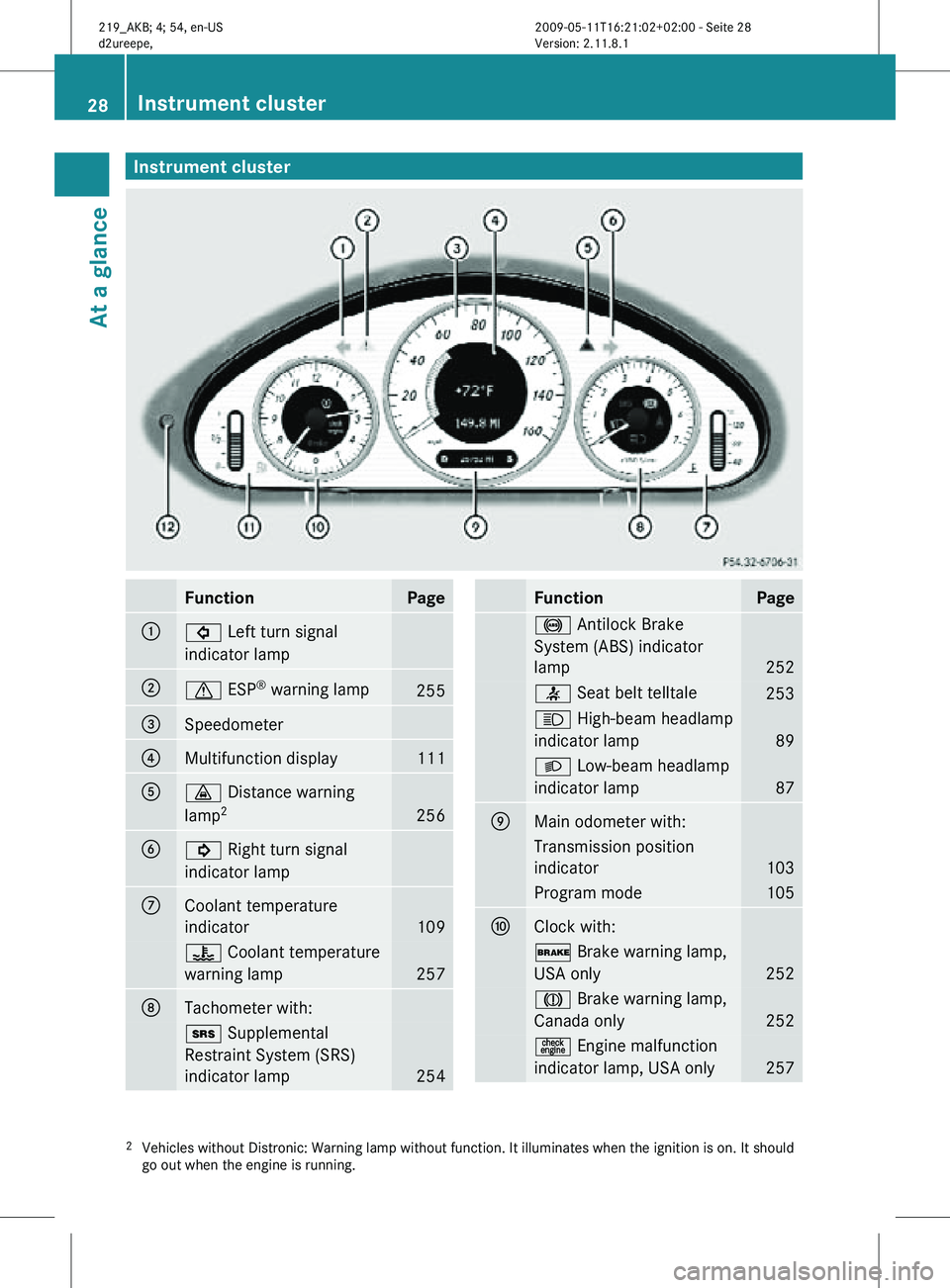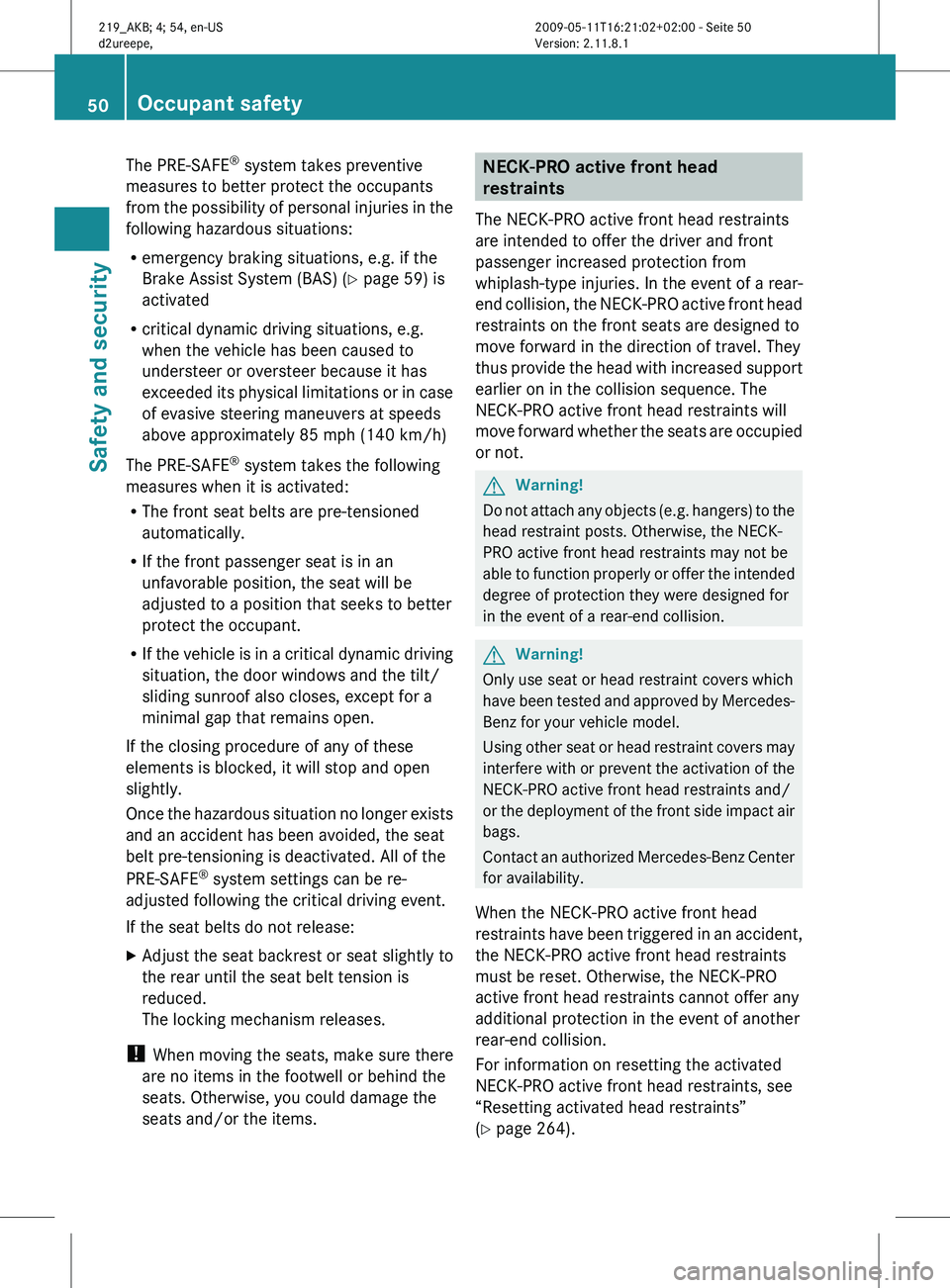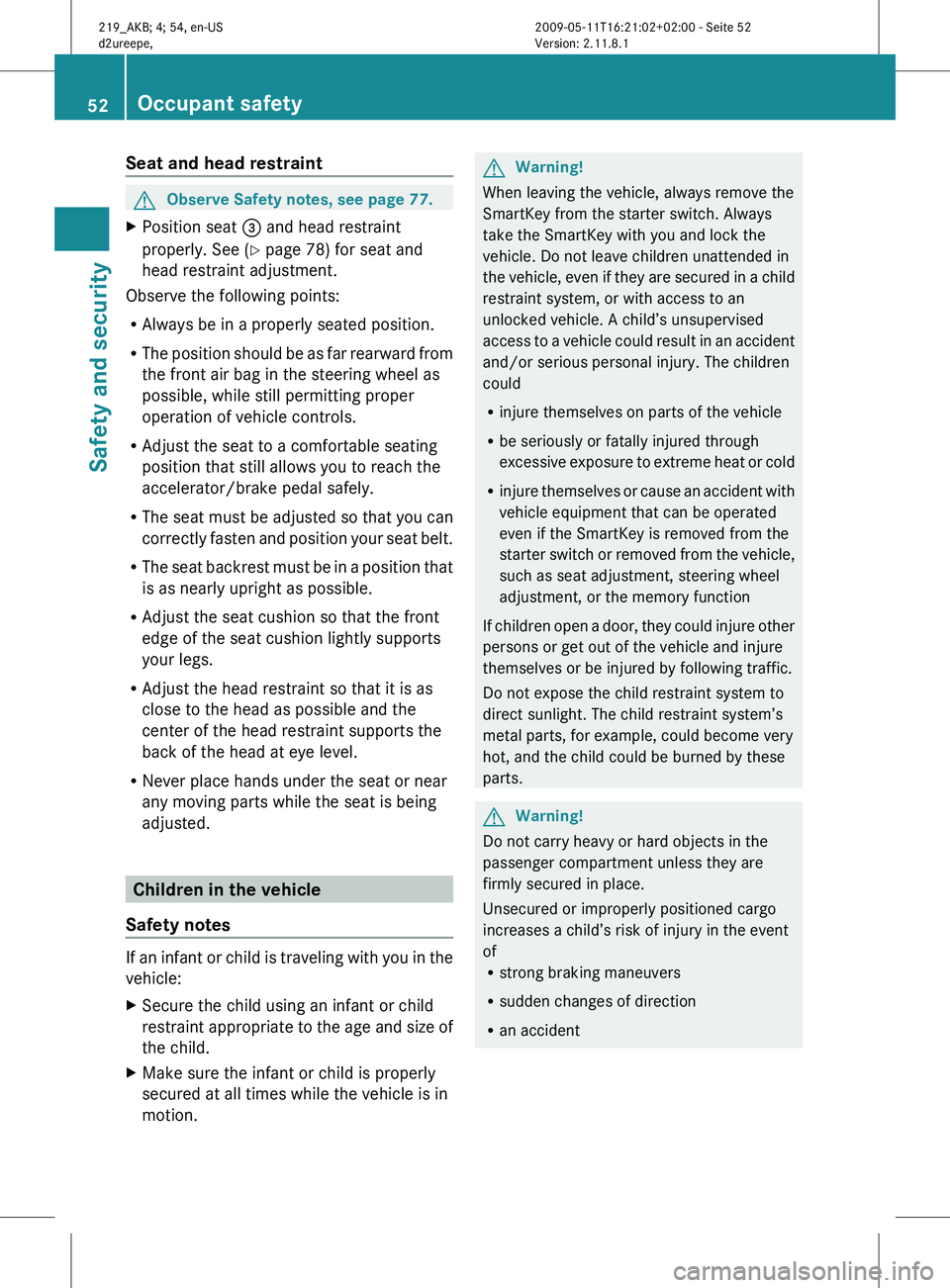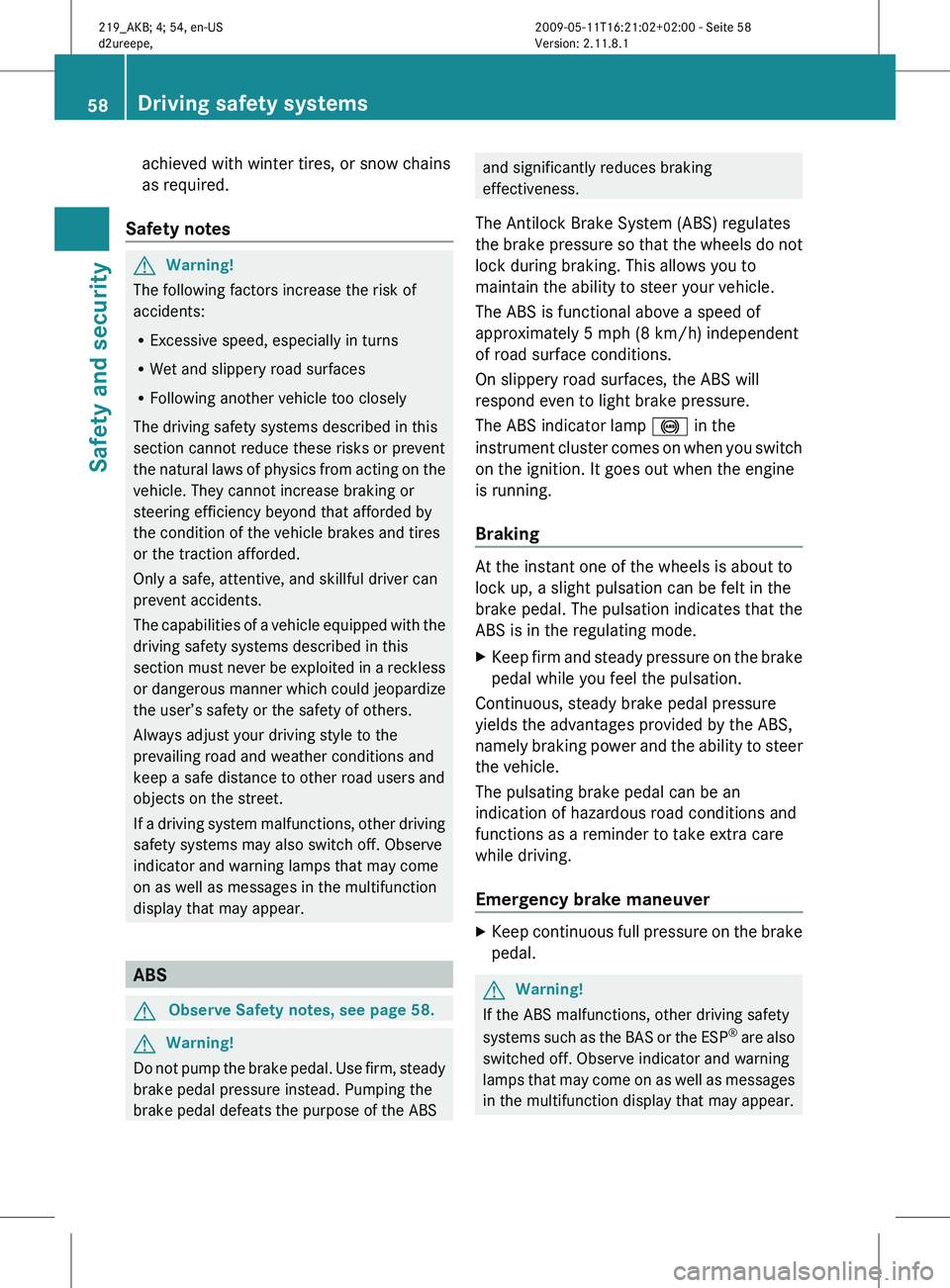2011 MERCEDES-BENZ CLS brake
[x] Cancel search: brakePage 17 of 308

Service and warranty information
.....19
Service intervals see
Maintenance System, Service
indicator message
Service life (tires) .............................. 198
Settings Factory setting (KEYLESS-GO) ......... 69
Factory setting (SmartKey) ..............67
Memory function .............................. 85
Menu ............................................. 118
Selective setting (KEYLESS-GO) ....... 69
Selective setting (SmartKey) ............67
Shelf below rear window, cleaning .. 221
Side impact air bags ...........................41
Side marker lamps
Cleaning lenses ............................. 219
Messages in the multifunction
display ........................................... 248
Sidewall (tires) .................................. 207
Ski bag ............................................... 155
SmartKey see Key, SmartKey
SmartKey with KEYLESS-GO
see Key, SmartKey
Snow chains ...................................... 208
Snow tires see Winter tires
Spare wheel ....................................... 291
Mounting ....................................... 272
Storage location ............................ 226
Speedometer ............................... 28, 131
Speed settings Cruise control ................................ 128
Distronic ........................................ 133
Resume function ................... 129, 134
SRS
Indicator lamp .................................. 28
SRS (Supplemental Restraint System)
Indicator lamp ......................... 36, 254
Messages in the multifunction
display ........................................... 240
Standing water, driving through ......213
Starter switch positions KEYLESS-GO .................................... 76
SmartKey ......................................... 76
Starting difficulties (engine) ..............98
Starting the engine ............................. 97Steering column
see Multifunction steering wheel,
Adjustment
Steering wheel
see Multifunction steering wheel
Steering wheel gearshift control .....106
Stolen Vehicle Recovery Services ...169
Storage compartments .....................158
Storing tires ....................................... 199
Sunroof see Power tilt/sliding sunroof
Sunshade
Rear window .................................. 162
Sun visors .................................. 161, 162
Suspension tuning see AIRMATIC DC (Dual Control) T
Tachometer ..................................
28, 110
Overspeed range ........................... 110
Tail lamps
Cleaning lenses ............................. 219
Messages in the multifunction
display ........................................... 249
Tar stains ........................................... 217
Technical data Air conditioning refrigerant ............ 298
Brake fluid ..................................... 298
Capacities fuels, coolants,
lubricants etc. ................................ 296
Coolant .......................................... 300
Engine oil additives ........................298
Engine oils ..................................... 298
Fuel requirements .......................... 299
Gasoline additives .......................... 299
Identification labels .......................288
Premium unleaded gasoline ...........299
Rims and tires ................................ 291
Spare wheel ................................... 296
Vehicle specification CLS 550 ....... 290
Vehicle specification CLS 63 AMG . 290
Washer and headlamp cleaning
system ................................... 297, 302
Technical data (dimensions)
see Vehicle specification
Technical data (electrical system)
see Vehicle specification Index
15 219_AKB; 4; 54, en-US
d2ureepe,
Version: 2.11.8.1 2009-05-11T16:21:02+02:00 - Seite 15
Page 20 of 308

Vehicle status message memory ....
117
Vehicle tool kit .................................. 224
Vehicle washing see Vehicle care
Vehicle weights
see Vehicle specification W
Warning lamps see Lamps, Indicator and warning
Warning sounds
Distance warning function .............137
Distronic ........................................ 131
Driver’s or passenger’s seat belt ..... 48
Parking brake ................................ 239
Parktronic system ..........................142
Seat belt telltale ............................ 253
Warranty coverage ............................ 288
Washer and headlamp cleaning
system ................................................ 302
Washer fluid
Messages in the multifunction
display ........................................... 242
Mixing ratio .................................... 302
Refilling .......................................... 181
Washing the vehicle .......................... 215
Wear pattern (tires) ..........................200
Weights (vehicle) see Vehicle specification
Wheel
Changing ....................................... 271
Removing ....................................... 274
Spare ............................................. 271
Tightening torque ........................... 277
Wheels, sizes ..................................... 291
Wheels, Tires and .............................. 182
Window curtain air bags ..................... 41
Windows see Power windows
Windows, cleaning ............................219
Windshield Cleaning wiper blades .................... 219
Defogging ...................................... 150
Washer fluid ................................... 302
Wipers ............................................. 92
Windshield wipers
Replacing wiper blades .................. 270Winter driving
Instructions
.................................... 209
Snow chains .................................. 208
Tires ............................................... 208
Winter tires ................................ 208, 291
Wood trims, cleaning ........................ 22118
Index 219_AKB; 4; 54, en-US
d2ureepe,
Version: 2.11.8.1 2009-05-11T16:21:02+02:00 - Seite 18
Page 29 of 308

Cockpit
Function Page
:
Combination switch:
Turn signals 89
Wipers 92
High beam 90
;
Cruise control lever:
Cruise control 127
Distronic 133
=
Steering wheel gearshift
control
105
?
Multifunction steering
wheel 29,
110 A
Instrument cluster 28,
108 B
Horn
C
Lever for Voice Control
System
1 D
Front Parktronic warning
indicator
139 Function Page
E
Climate control panel 143
F
Overhead control panel 33
G
Glove box 158
H
COMAND system
1 I
Center console 31
J
Starter switch 76
K
Steering wheel adjustment
stalk
82
Heated steering wheel 83
L
Parking brake pedal 100
M
Parking brake release 100
N
Exterior lamp switch 87
O
Door control panel 32
P
On-board diagnostics
(OBD) socket
Q
Hood lock release lever 178
1
See separate operating instructions. Cockpit
27At a glance
219_AKB; 4; 54, en-US
d2ureepe, Version: 2.11.8.1 2009-05-11T16:21:02+02:00 - Seite 27 Z
Page 30 of 308

Instrument cluster
Function Page
:
# Left turn signal
indicator lamp
;
d ESP
®
warning lamp 255
=
Speedometer
?
Multifunction display 111
A
· Distance warning
lamp
2 256
B
! Right turn signal
indicator lamp
C
Coolant temperature
indicator
109
? Coolant temperature
warning lamp
257
D
Tachometer with:
+ Supplemental
Restraint System (SRS)
indicator lamp
254 Function Page
! Antilock Brake
System (ABS) indicator
lamp
252
7 Seat belt telltale
253
K High-beam headlamp
indicator lamp
89
L Low-beam headlamp
indicator lamp
87
E
Main odometer with:
Transmission position
indicator
103
Program mode 105
F
Clock with:
$ Brake warning lamp,
USA only
252
J Brake warning lamp,
Canada only
252
= Engine malfunction
indicator lamp, USA only
257
2
Vehicles without Distronic: Warning lamp without function. It illuminates when the ignition is on. It should
go out when the engine is running. 28
Instrument clusterAt a glance
219_AKB; 4; 54, en-US
d2ureepe,
Version: 2.11.8.1 2009-05-11T16:21:02+02:00 - Seite 28
Page 52 of 308

The PRE-SAFE
®
system takes preventive
measures to better protect the occupants
from
the possibility of personal injuries in the
following hazardous situations:
R emergency braking situations, e.g. if the
Brake Assist System (BAS) ( Y page 59) is
activated
R critical dynamic driving situations, e.g.
when the vehicle has been caused to
understeer or oversteer because it has
exceeded its physical limitations or in case
of evasive steering maneuvers at speeds
above approximately 85 mph (140 km/h)
The PRE-SAFE ®
system takes the following
measures when it is activated:
R The front seat belts are pre-tensioned
automatically.
R If the front passenger seat is in an
unfavorable position, the seat will be
adjusted to a position that seeks to better
protect the occupant.
R If the vehicle is in a critical dynamic driving
situation, the door windows and the tilt/
sliding sunroof also closes, except for a
minimal gap that remains open.
If the closing procedure of any of these
elements is blocked, it will stop and open
slightly.
Once the hazardous situation no longer exists
and an accident has been avoided, the seat
belt pre-tensioning is deactivated. All of the
PRE-SAFE ®
system settings can be re-
adjusted following the critical driving event.
If the seat belts do not release:
X Adjust the seat backrest or seat slightly to
the rear until the seat belt tension is
reduced.
The locking mechanism releases.
! When moving the seats, make sure there
are no items in the footwell or behind the
seats. Otherwise, you could damage the
seats and/or the items. NECK-PRO active front head
restraints
The NECK-PRO active front head restraints
are intended to offer the driver and front
passenger increased protection from
whiplash-type injuries. In the event of a rear-
end
collision, the NECK-PRO active front head
restraints on the front seats are designed to
move forward in the direction of travel. They
thus provide the head with increased support
earlier on in the collision sequence. The
NECK-PRO active front head restraints will
move forward whether the seats are occupied
or not. G
Warning!
Do not attach any objects (e.g. hangers) to the
head restraint posts. Otherwise, the NECK-
PRO active front head restraints may not be
able
to function properly or offer the intended
degree of protection they were designed for
in the event of a rear-end collision. G
Warning!
Only use seat or head restraint covers which
have
been tested and approved by Mercedes-
Benz for your vehicle model.
Using other seat or head restraint covers may
interfere with or prevent the activation of the
NECK-PRO active front head restraints and/
or the deployment of the front side impact air
bags.
Contact an authorized Mercedes-Benz Center
for availability.
When the NECK-PRO active front head
restraints have been triggered in an accident,
the NECK-PRO active front head restraints
must be reset. Otherwise, the NECK-PRO
active front head restraints cannot offer any
additional protection in the event of another
rear-end collision.
For information on resetting the activated
NECK-PRO active front head restraints, see
“Resetting activated head restraints”
(Y page 264). 50
Occupant safety
Safety and security
219_AKB; 4; 54, en-US
d2ureepe,
Version: 2.11.8.1 2009-05-11T16:21:02+02:00 - Seite 50
Page 54 of 308

Seat and head restraint
G
Observe Safety notes, see page 77.
X Position seat = and head restraint
properly. See ( Y page 78) for seat and
head restraint adjustment.
Observe the following points:
R Always be in a properly seated position.
R The
position should be as far rearward from
the front air bag in the steering wheel as
possible, while still permitting proper
operation of vehicle controls.
R Adjust the seat to a comfortable seating
position that still allows you to reach the
accelerator/brake pedal safely.
R The seat must be adjusted so that you can
correctly fasten and position your seat belt.
R The seat backrest must be in a position that
is as nearly upright as possible.
R Adjust the seat cushion so that the front
edge of the seat cushion lightly supports
your legs.
R Adjust the head restraint so that it is as
close to the head as possible and the
center of the head restraint supports the
back of the head at eye level.
R Never place hands under the seat or near
any moving parts while the seat is being
adjusted. Children in the vehicle
Safety notes If an infant or child is traveling with you in the
vehicle:
X
Secure the child using an infant or child
restraint
appropriate to the age and size of
the child.
X Make sure the infant or child is properly
secured at all times while the vehicle is in
motion. G
Warning!
When leaving the vehicle, always remove the
SmartKey from the starter switch. Always
take the SmartKey with you and lock the
vehicle. Do not leave children unattended in
the
vehicle, even if they are secured in a child
restraint system, or with access to an
unlocked vehicle. A child’s unsupervised
access to a vehicle could result in an accident
and/or serious personal injury. The children
could
R injure themselves on parts of the vehicle
R be seriously or fatally injured through
excessive exposure to extreme heat or cold
R injure themselves or cause an accident with
vehicle equipment that can be operated
even if the SmartKey is removed from the
starter switch or removed from the vehicle,
such as seat adjustment, steering wheel
adjustment, or the memory function
If children open a door, they could injure other
persons or get out of the vehicle and injure
themselves or be injured by following traffic.
Do not expose the child restraint system to
direct sunlight. The child restraint system’s
metal parts, for example, could become very
hot, and the child could be burned by these
parts. G
Warning!
Do not carry heavy or hard objects in the
passenger compartment unless they are
firmly secured in place.
Unsecured or improperly positioned cargo
increases a child’s risk of injury in the event
of
R strong braking maneuvers
R sudden changes of direction
R an accident 52
Occupant safety
Safety and security
219_AKB; 4; 54, en-US
d2ureepe,
Version: 2.11.8.1 2009-05-11T16:21:02+02:00 - Seite 52
Page 59 of 308

X
Activating: Press override switch :.
Indicator lamp ; comes on.
The functions in the rear are disabled.
You can still operate the rear door windows
using the switches located on the door
control panel of the driver’s door.
X Deactivating: Press override switch :
again.
Indicator lamp ; goes out.
The functions in the rear are enabled again.
For more information on power windows, see
the “Controls in detail” section
(Y page 94). Panic alarm
Example illustration: SmartKey with KEYLESS-GO
X
Activating: Press and hold !
button : for at least 1 second.
An audible alarm and flashing exterior
lamps will operate.
X Deactivating: Press ! button : again.
or
X Insert the SmartKey into the starter switch.
or
X Press the KEYLESS-GO start/stop button.
The SmartKey with KEYLESS-GO must be
inside the vehicle. i
USA only:
This device complies with Part 15 of the
FCC Rules. Operation is subject to the
following two conditions:
1. This device may not cause harmful interference, and
2. this device must accept any interference received, including
interference that may cause undesired
operation.
Any unauthorized modification to this
device could void the user’s authority to
operate the equipment.
i Canada only:
This device complies with RSS-210 of
Industry Canada. Operation is subject to
the following two conditions:
1. This device may not cause interference, and
2. this device must accept any interference received, including
interference that may cause undesired
operation of the device.
Any unauthorized modification to this
device could void the user’s authority to
operate the equipment. Driving safety systems
Introduction
This section contains information about the
following driving safety systems:
R ABS ( Antilock Brake System)
R Adaptive Brake
R BAS ( Brake Assist System)
R EBP ( Electronic Brake Proportioning)
R ESP ®
( Electronic Stability Program)
i In winter operation, the maximum
effectiveness of most of the driving
systems described in this section is only Driving safety systems
57Safety and security
219_AKB; 4; 54, en-US
d2ureepe, Version: 2.11.8.1 2009-05-11T16:21:02+02:00 - Seite 57 Z
Page 60 of 308

achieved with winter tires, or snow chains
as required.
Safety notes G
Warning!
The following factors increase the risk of
accidents:
R Excessive speed, especially in turns
R Wet and slippery road surfaces
R Following another vehicle too closely
The driving safety systems described in this
section cannot reduce these risks or prevent
the
natural laws of physics from acting on the
vehicle. They cannot increase braking or
steering efficiency beyond that afforded by
the condition of the vehicle brakes and tires
or the traction afforded.
Only a safe, attentive, and skillful driver can
prevent accidents.
The capabilities of a vehicle equipped with the
driving safety systems described in this
section must never be exploited in a reckless
or dangerous manner which could jeopardize
the user’s safety or the safety of others.
Always adjust your driving style to the
prevailing road and weather conditions and
keep a safe distance to other road users and
objects on the street.
If a driving system malfunctions, other driving
safety systems may also switch off. Observe
indicator and warning lamps that may come
on as well as messages in the multifunction
display that may appear. ABS
G
Observe Safety notes, see page 58. G
Warning!
Do not pump the brake pedal. Use firm, steady
brake pedal pressure instead. Pumping the
brake pedal defeats the purpose of the ABS and significantly reduces braking
effectiveness.
The Antilock Brake System (ABS) regulates
the
brake pressure so that the wheels do not
lock during braking. This allows you to
maintain the ability to steer your vehicle.
The ABS is functional above a speed of
approximately 5 mph (8 km/h) independent
of road surface conditions.
On slippery road surfaces, the ABS will
respond even to light brake pressure.
The ABS indicator lamp ! in the
instrument cluster comes on when you switch
on the ignition. It goes out when the engine
is running.
Braking At the instant one of the wheels is about to
lock up, a slight pulsation can be felt in the
brake pedal. The pulsation indicates that the
ABS is in the regulating mode.
X
Keep firm and steady pressure on the brake
pedal while you feel the pulsation.
Continuous, steady brake pedal pressure
yields the advantages provided by the ABS,
namely
braking power and the ability to steer
the vehicle.
The pulsating brake pedal can be an
indication of hazardous road conditions and
functions as a reminder to take extra care
while driving.
Emergency brake maneuver X
Keep continuous full pressure on the brake
pedal. G
Warning!
If the ABS malfunctions, other driving safety
systems
such as the BAS or the ESP ®
are also
switched off. Observe indicator and warning
lamps that may come on as well as messages
in the multifunction display that may appear. 58
Driving safety systems
Safety and security
219_AKB; 4; 54, en-US
d2ureepe,
Version: 2.11.8.1 2009-05-11T16:21:02+02:00 - Seite 58